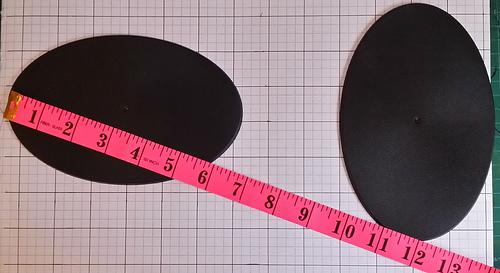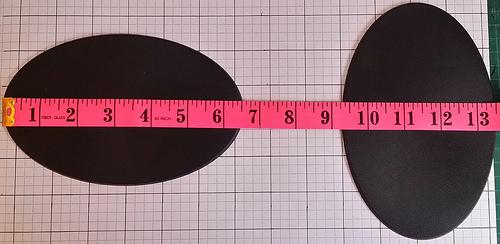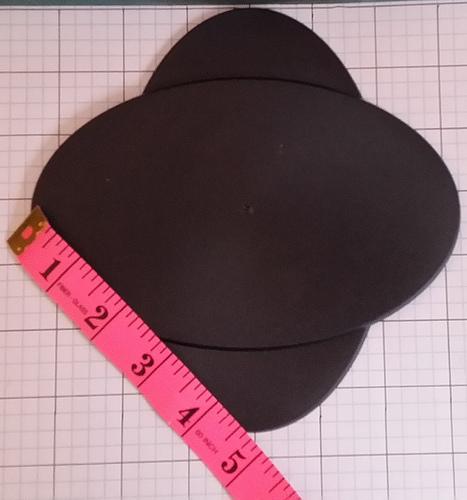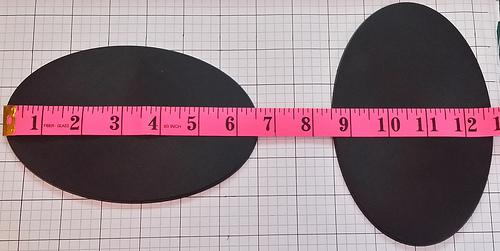| Author |
Message |
 |
|
|
 |
|
Advert
|
Forum adverts like this one are shown to any user who is not logged in. Join us by filling out a tiny 3 field form and you will get your own, free, dakka user account which gives a good range of benefits to you:
- No adverts like this in the forums anymore.
- Times and dates in your local timezone.
- Full tracking of what you have read so you can skip to your first unread post, easily see what has changed since you last logged in, and easily see what is new at a glance.
- Email notifications for threads you want to watch closely.
- Being a part of the oldest wargaming community on the net.
If you are already a member then feel free to login now. |
|
 |
![[Post New]](/s/i/i.gif) 2019/02/25 18:01:39
Subject: Knight movement an bases pivoting.
|
 |

Liche Priest Hierophant
|
Hi.
How do you measure base movement in 8th edition? In this instance the knight.
The movement rules for 8th edition states that no part of the model can move more then the allowed movement. 12" in the case of a knight.
How is this measured? 8th edition never gets very spesific about it. It does clarify that no part of the model can be within 1" of an enemy model during the movement. This indicates that you physically move the base the entier time and do not in fact measure from point A to point B and see if it moves more then 12".
If this is true and you pivot around your own base you need to calculate the amount of pivoting either by math or with a ruler. In the case of the 160 mm x 100 mm knight base it has a circumvent of 19,8 inchens ("). If you pivot it 90¤ degrees around its own axes you would then need to calculate a 4,9" movement. If you pivot it along the lenght of it's base (like the hands of a clock) you double the duameter and a 90¤ pivit would in fact take up 9,8" of movement. Does pivoting as part of the movement somehow decrease this? My math says no. It only makes it harder to measure.
Or is this all wrong and you just measure the distance from point A to B and do not calculate in pivoting. I know you do not measure from point C to point B,
It got debated a lot in another thread. I would like to hear how you interpret it, or if there even are solutions I have not thought about.
![[Thumb - knight problem.png]](/s/i/at/2019/2/25/2dfb2c0f39a6b211b46c68fac82c824b_33527.png__thumb)
|
|
|
This message was edited 2 times. Last update was at 2019/02/25 18:04:31
|
|
|
 |
 |
![[Post New]](/s/i/i.gif) 2019/02/25 18:11:44
Subject: Knight movement an bases pivoting.
|
 |

Horrific Hive Tyrant
|
No point on the model can move more than the movement distance. Easiest way to check that is agree which point moved the furthest, and measure start point and finish.
Yes, this does mean that pivoting "costs" movement. But it's generally not as complicated as you make out.
Also bare in mind that there's generally no need to pivot in 8e (except for certain flyers), as facing doesn't matter and you can shoot from any point on the model.
|
|
|
 |
 |
![[Post New]](/s/i/i.gif) 2019/02/25 18:13:35
Subject: Knight movement an bases pivoting.
|
 |

Norn Queen
|
Unlike previous editions, pivoting a non circular base "costs" movement. No point of the base may move further than the maximum move of the unit. You're better off measuring the distance first without pivoting, then pivoting so the point of where you want the base is touching that distance.
|
|
This message was edited 1 time. Last update was at 2019/02/25 18:14:34
|
|
|
 |
 |
![[Post New]](/s/i/i.gif) 2019/02/25 18:15:13
Subject: Re:Knight movement an bases pivoting.
|
 |

Fireknife Shas'el
|
I believe the rules don't require you to measure rotation arcs, which are messy and difficult to measure. All measuring can be done via straight lines, so long as you remember the golden rule, that no point on the base (or hull) can move more than the movement statistic of the model. And by this I mean that point 'ends' no more than (movement stat) away from its start point, and the turning/pivoting/wiggling from point to point is irrelevant, only the final displacement matters.
I made some pictures to highlight the issue with regards to moving:

This image shows the displacement of the knight while pivoting and moving 12"

This one shows the total forward distance the knight actually moved (roughly 9 1/4", losing effectively 2 3/4" inches overall)

This one shows how far (straight line) the point on the base has displaced during a pivot (just over 4 1/2"). This is relevant more for flyers, which must pivot before moving. Note that if you had to account for pivoting then moving, the knight would have only moved 7 3/4" forwards in the 2nd image, not 9 1/4". Even less if you had to account for arc sweep of the oval rather than simply point displacement.
|
|
|
|
 |
 |
![[Post New]](/s/i/i.gif) 2019/02/25 18:29:18
Subject: Re:Knight movement an bases pivoting.
|
 |

Liche Priest Hierophant
|
Thanks for the responses.
I just think that this part of the rules is very sloppy written as it is upen to interpretation,
If you look at the picture I have in this point how to de measure between point A and B? The distance between A and B is the shortest using the purple line. How ever, the model can not move using the purple line without having some unintensional movement in the other side of the base. The shortest possible way to move would be to pivot the base along it's own axess, is it not? In that case you will need to measure not along the pruple line but the yellow coloour between point A and B, and this is longer. You can see this in John Prins 2nd picture.
Am I wrong here? The senario I am descirbing is John Prins 3rd example. Can you confirm the siece of the base in the picture, are they 160 mm times 100 mm. Because acording to my math it should be 4,9 if you do the pivot and do not use the staright pruple line. (Like the rules does.)
Likevice if we look at John Prins picture 1 the base ends up 12" away. But every point on the base would end up moving more then 12", would it not? Pivoting on a spot around it's own acess would be 4,9" movement, leaving 7" moving the base to the right. I do not think this is any of John Prins Pictures.
This depends if we measure every part of movement, but the rules states we need to, do we not? Othervice the base would at some point move further then it was allowed?
Please help.
![[Thumb - knight problem 2.png]](/s/i/at/2019/2/25/4f023e5908581fd37f836d419231f20b_33527.png__thumb)
|
|
|
This message was edited 2 times. Last update was at 2019/02/25 18:36:12
|
|
|
 |
 |
![[Post New]](/s/i/i.gif) 2019/02/25 18:38:19
Subject: Knight movement an bases pivoting.
|
 |

Horrific Hive Tyrant
|
Honestly, you're getting into differences that are too small to worry about, on a practical level.
There's a big margin of error in how any measuring in a game like this is done.
|
|
|
 |
 |
![[Post New]](/s/i/i.gif) 2019/02/25 18:50:07
Subject: Re:Knight movement an bases pivoting.
|
 |

Fireknife Shas'el
|
 Niiai wrote: Niiai wrote:
I just think that this part of the rules is very sloppy written as it is upen to interpretation,
Agreed!
If you look at the picture I have in this point how to de measure between point A and B? The distance between A and B is the shortest using the purple line. How ever, the model can not move using the purple line without having some unintensional movement in the other side of the base. The shortest possible way to move would be to pivot the base along it's own axess, is it not? In that case you will need to measure not along the pruple line but the yellow coloour between point A and B, and this is longer. You can see this in John Prins 2nd picture.
Think of it this way: I could pick up a model, walk across the room and back again, and put the model down 12" from where it started. That's a legal movement for the model, even though it actually traveled 15 feet or more through space. Only where the model started, and where it ended, matters.
Likevice if we look at John Prins picture 1 the base ends up 12" away. But every point on the base would end up moving more then 12", would it not?.
In the first picture, the point on the long axis has moved 12". The center has moved far less, and every point on the base should have displaced 12" or less.
Don't get stuck on arc movement through turns, because it's basically impossible to measure. The rules say any POINT on the model can't move more than the movement stat, and that to me means only starting and ending placement needs to be considered - otherwise you've got the 'walk the room' problem above. People constantly re-position models while moving them, back and forth. Does that count as movement? I don't think so.
Where did it start, where did it finish, is any point further than movement stat away from its start? These are the important concerns.
Edit: Keeping in mind sometimes you have to go around stuff like obstacles, which makes things messier and you might not be able to measure in a single straight line. That's why I bring a flexible tape if I can.
Edit2: Those are the bases that came with Renegade, they're Knight bases. My measurements may not be exactly 90 degrees to each other, I was eyeballing it. Note the large grid I drew on the paper is 1", that's 1/4" graph paper.
|
|
This message was edited 2 times. Last update was at 2019/02/25 19:00:17
|
|
|
 |
 |
![[Post New]](/s/i/i.gif) 2019/02/25 18:57:35
Subject: Re:Knight movement an bases pivoting.
|
 |

Grisly Ghost Ark Driver
|
 John Prins wrote: John Prins wrote: Niiai wrote: Niiai wrote:
I just think that this part of the rules is very sloppy written as it is upen to interpretation,
Agreed!
If you look at the picture I have in this point how to de measure between point A and B? The distance between A and B is the shortest using the purple line. How ever, the model can not move using the purple line without having some unintensional movement in the other side of the base. The shortest possible way to move would be to pivot the base along it's own axess, is it not? In that case you will need to measure not along the pruple line but the yellow coloour between point A and B, and this is longer. You can see this in John Prins 2nd picture.
Think of it this way: I could pick up a model, walk across the room and back again, and put the model down 12" from where it started. That's a legal movement for the model, even though it actually traveled 15 feet or more through space. Only where the model started, and where it ended, matters.
Likevice if we look at John Prins picture 1 the base ends up 12" away. But every point on the base would end up moving more then 12", would it not?.
In the first picture, the point on the long axis has moved 12". The center has moved far less, and every point on the base should have displaced 12" or less.
Don't get stuck on arc movement through turns, because it's basically impossible to measure. The rules say any POINT on the model can't move more than the movement stat, and that to me means only starting and ending placement needs to be considered - otherwise you've got the 'walk the room' problem above. People constantly re-position models while moving them, back and forth. Does that count as movement? I don't think so.
Where did it start, where did it finish, is any point further than movement stat away from its start? These are the important concerns.
Your generalization makes it sound like it can ignore terrain, which of course has to be a disclaimer from said room walk.
What if the knight moves through a gap in the terrain, a gate in a wall, to emerge on the other side. As it squeezes through that opening it rotates 90 degrees and on the other side it wants to rotate back level again, because reasons. From start to end it now stands as if it phased through the wall, surely it can't do that. Now you have to measure each point of the base as it physically travelled along a path, and no room walking allowed!
|
|
This message was edited 1 time. Last update was at 2019/02/25 19:00:02
|
|
|
 |
 |
![[Post New]](/s/i/i.gif) 2019/02/25 19:04:26
Subject: Re:Knight movement an bases pivoting.
|
 |

Fireknife Shas'el
|
torblind wrote:
Your generalization makes it sound like it can ignore terrain, which of course has to be a disclaimer from said room walk.
What if the knight moves through a gap in the terrain, a gate in a wall, to emerge on the other side. As it squeezes through that opening it rotates 90 degrees and on the other side it wants to rotate back level again, because reasons. From start to end it now stands as if it phased through the wall, surely it can't do that. Now you have to measure each point of the base as it physically travelled along a path, and no room walking allowed!
See edits above, I thought of that right after posting. Best case you would move as far as you could to fit the gap, pivoting while doing so, then move through in a straight line, then pivot out once clear. Basically you break the movement down into multiple straight lines, the sum of which should not exceed (in this case) 12".
You can see how a flexible measuring tape can be helpful in these situations.
|
|
This message was edited 1 time. Last update was at 2019/02/25 19:04:36
|
|
|
 |
 |
![[Post New]](/s/i/i.gif) 2019/02/25 19:11:40
Subject: Knight movement an bases pivoting.
|
 |

Rogue Daemonhunter fueled by Chaos
|
I'm not normally a huge of RAW at all costs, but I really don't see another way to play this, other than the way it lists in the rules.
The only real reason for a model (mostly notably knights, but also in theory some of the longer vehicles) would be to squeeze through tight avenues between terrain, and it makes sense to me that a knight would have to slow down to essentially walk sideways.
|
|
|
 |
 |
![[Post New]](/s/i/i.gif) 2019/02/25 19:18:15
Subject: Knight movement an bases pivoting.
|
 |

Grim Dark Angels Interrogator-Chaplain
|
People want terrain to matter. This is one way it does, if your larger models have to manoeuvre.
In regard to OP’s question, don’t work out the curved distance. The actual distance traveled is from start to end points. Just measure that.
|
 Stormonu wrote: Stormonu wrote:For me, the joy is in putting some good-looking models on the board and playing out a fantasy battle - not arguing over the poorly-made rules of some 3rd party who neither has any power over my play nor will be visiting me (and my opponent) to ensure we are "playing by the rules"
|
|
|
 |
 |
![[Post New]](/s/i/i.gif) 2019/02/25 19:24:45
Subject: Re:Knight movement an bases pivoting.
|
 |

Liche Priest Hierophant
|
 John Prins wrote: John Prins wrote:torblind wrote:
Your generalization makes it sound like it can ignore terrain, which of course has to be a disclaimer from said room walk.
What if the knight moves through a gap in the terrain, a gate in a wall, to emerge on the other side. As it squeezes through that opening it rotates 90 degrees and on the other side it wants to rotate back level again, because reasons. From start to end it now stands as if it phased through the wall, surely it can't do that. Now you have to measure each point of the base as it physically travelled along a path, and no room walking allowed!
See edits above, I thought of that right after posting. Best case you would move as far as you could to fit the gap, pivoting while doing so, then move through in a straight line, then pivot out once clear. Basically you break the movement down into multiple straight lines, the sum of which should not exceed (in this case) 12".
You can see how a flexible measuring tape can be helpful in these situations.
Thanks for the discussion so far. It is good to see I am not the only one finding this odd.
The first examples, where you move the model around the room, and it ends up 12" from where it started, that is perfectly legal. Asuming you did not move any part of the base more then 12" during the movement.
If my math checks out, the smallest way to not use to much movement on pivoting, you need to pivot around the base. As the picture below, you would then need to measure the yellow line. As it is impossible for the base to move on the purple line withouth having a lot of unitensional movement for the rest of the base if you use the purple line. (While point A to B would travel shorter the rest of the base would travel much further, hence pivoting upon it's own axcis.)
Now, if you pivot 90¤, move through a gate 2", and pivot back 90¤ that is 12" movement, as showed on my math, a 90¤ pivot around it's own axces on a 160mm base takes up 5" movement. 5+ 2+ 5 = 12" movement for every part of the base, but only a 2" movement on the table.
Automatically Appended Next Post:
 JohnnyHell wrote: JohnnyHell wrote:People want terrain to matter. This is one way it does, if your larger models have to manoeuvre.
In regard to OP’s question, don’t work out the curved distance. The actual distance traveled is from start to end points. Just measure that.
If you just measure from start to end point, not curved distance, that means that the polar other part of the base has moved much more then 12" as pivoting around it's own axcess is the best way to reduce unesaseraly movement.
![[Thumb - knight problem 2.png]](/s/i/at/2019/2/25/497f208553fe2dddb5a2e2baca404450_33527.png__thumb)
|
|
|
This message was edited 3 times. Last update was at 2019/02/25 19:27:56
|
|
|
 |
 |
![[Post New]](/s/i/i.gif) 2019/02/25 19:34:55
Subject: Knight movement an bases pivoting.
|
 |

Grim Dark Angels Interrogator-Chaplain
|
I meant “effective” or “practical” rather than actual distance, my poor phrasing. It’s a game of toy soldiers, not pure maths. Take the easy route.
|
 Stormonu wrote: Stormonu wrote:For me, the joy is in putting some good-looking models on the board and playing out a fantasy battle - not arguing over the poorly-made rules of some 3rd party who neither has any power over my play nor will be visiting me (and my opponent) to ensure we are "playing by the rules"
|
|
|
 |
 |
![[Post New]](/s/i/i.gif) 2019/02/25 19:42:50
Subject: Re:Knight movement an bases pivoting.
|
 |

Fireknife Shas'el
|
 Niiai wrote: Niiai wrote:
If you just measure from start to end point, not curved distance, that means that the polar other part of the base has moved much more then 12" as pivoting around it's own axcess is the best way to reduce unesaseraly movement.
You should be able to intuit which point is likely to move the most. In my first example, one point of the long axis is moving 12". Everything else should be moving less than 12".
Pivoting the oval on the center is by default the MOST costly in terms of movement. Pivoting while traveling should be more efficient, but measuring it is a geometric puzzle beyond the needs of playing a game of 40k. That's why point displacement is the only reasonable option for measuring. No point can end up more than (in this case) 12" away from where it started. If it traversed more than 12" in the process, I think that's okay, because ovals will typically move less distance than a circular base will - why punish them even more?
|
|
|
|
 |
 |
![[Post New]](/s/i/i.gif) 2019/02/25 19:45:20
Subject: Re:Knight movement an bases pivoting.
|
 |

Liche Priest Hierophant
|
For some one who is good at math both routes are easy. But one of them end up being wrong. Knowing a knight pivoting 90¤ around it's own base = 5" in movement is a nice shorthand when moving bases of these siezes. A 45" turn = 2,5".
While Point A travel in a short line in this picture, point B end up traveling a rather longer way then the allowed 12".
Automatically Appended Next Post:
 John Prins wrote: John Prins wrote: Niiai wrote: Niiai wrote:
If you just measure from start to end point, not curved distance, that means that the polar other part of the base has moved much more then 12" as pivoting around it's own axcess is the best way to reduce unesaseraly movement.
You should be able to intuit which point is likely to move the most. In my first example, one point of the long axis is moving 12". Everything else should be moving less than 12".
Pivoting the oval on the center is by default the MOST costly in terms of movement. Pivoting while traveling should be more efficient, but measuring it is a geometric puzzle beyond the needs of playing a game of 40k. That's why point displacement is the only reasonable option for measuring. No point can end up more than (in this case) 12" away from where it started. If it traversed more than 12" in the process, I think that's okay, because ovals will typically move less distance than a circular base will - why punish them even more?
Well this is in part what I am asking. Do you move less when you pivot during movement, then if you pivot and the move? Shurly the amount of movement would be: Math of the pivot + Distance. No mather if you pivot during the move or not, it is just harder to measure. Or am I mistaken in this? I am not good enough in math to tell, but I suspect it is true. In the bottom picture point B would in fact have moved 21,8. I suspect the same is true for pivoting during movement as well.
![[Thumb - knight problem 3.jpg]](/s/i/at/2019/2/25/4545728702a6dcf5bff1f27a24f1414b_33527.jpg__thumb)
|
![[Thumb - knight problem 4.jpg]](/s/i/at/2019/2/25/0de951812b99c79f5ba946e4c822d04b_33527.jpg__thumb)
|
|
|
This message was edited 3 times. Last update was at 2019/02/25 20:04:42
|
|
|
 |
 |
![[Post New]](/s/i/i.gif) 2019/02/25 20:03:07
Subject: Re:Knight movement an bases pivoting.
|
 |

Fireknife Shas'el
|
 Niiai wrote: Niiai wrote:
Well this is in part what I am asking. Do you move less when you pivot during movement, then if you pivot and the move? Shurly the amount of movement would be: Math of the pivot + Distance. No mather if you pivot during the move or not, it is just harder to measure. Or am I mistaken in this? I am not good enough in math to tell, but I suspect it is true.
Note the image I gave assumed moving right to left (vertical to horizontal, going right to left). The tape measures the displacement of the lower right point TO the far left point.
There are literally infinite number of potential pivoting arcs that can be made during that movement. The shortest arc may well be more than 12" of curved line for point to point, but the displacement of points is 12", and it's way easier to determine.
If have a 12" piece of flexible rubber to lay down and you can trace the arc of the base edge along the rubber, but to 100% legal you'd have to make sure EVERY point on the model doesn't traverse more. Can you measure every point's arc of traverse? Not without some serious computer modelling.
Ultimately, however, it only matters if the part closest to the enemy at the end of movement moves 12" or less. That's what measures shooting and charging. There may be other concerns (like back-field auras clipping the back of your model), but again, the part that moves the furthest should be intuitive.
|
|
This message was edited 1 time. Last update was at 2019/02/25 20:06:37
|
|
|
 |
 |
![[Post New]](/s/i/i.gif) 2019/02/25 20:07:22
Subject: Knight movement an bases pivoting.
|
 |

Liche Priest Hierophant
|
I guess my question would be do I need to trace the arc of the base? Would it not be sufficient to count the pivot + the distance moved? While you can combine them into one move that is harder to calculate, it would end up measuring the same, would it not?
|
|
|
|
 |
 |
![[Post New]](/s/i/i.gif) 2019/02/25 20:20:03
Subject: Knight movement an bases pivoting.
|
 |

Horrific Hive Tyrant
|
 Niiai wrote: Niiai wrote:I guess my question would be do I need to trace the arc of the base? Would it not be sufficient to count the pivot + the distance moved? While you can combine them into one move that is harder to calculate, it would end up measuring the same, would it not?
Are you looking for a strict RAW standard that no one plays to, or a practical answer that people actually use?
|
|
|
 |
 |
![[Post New]](/s/i/i.gif) 2019/02/25 20:21:05
Subject: Knight movement an bases pivoting.
|
 |

Fireknife Shas'el
|
 Niiai wrote: Niiai wrote:I guess my question would be do I need to trace the arc of the base? Would it not be sufficient to count the pivot + the distance moved? While you can combine them into one move that is harder to calculate, it would end up measuring the same, would it not?
I don't think it's necessary to trace the arc of the base. Too complex.
You could pivot then move linearly if you choose. That's a good example of breaking the movement into several lines, but it's likely very inefficient!
OTOH, you could just base a knight on a 160mm round base. You'd never be able to squeeze through 105mm gaps like the oval, but you get zero arguments. Dunno if that's tournament legal, though 
|
|
|
|
 |
 |
![[Post New]](/s/i/i.gif) 2019/02/25 20:23:04
Subject: Knight movement an bases pivoting.
|
 |

Liche Priest Hierophant
|
The RAW awnser. If my suspecions are right you can just use the 5" as an actual measurement when somebody pivots 90¤, or 2,5 when somebody pivots 45¤.
Last game I played the ork vehicles did a lot of free pivots. Least of all at the end of a charge where it used it's long base to lock two seperate units in close combat.
|
|
|
|
 |
 |
![[Post New]](/s/i/i.gif) 2019/02/25 20:28:46
Subject: Knight movement an bases pivoting.
|
 |

Fixture of Dakka
|
There are no rules, just "dont move any part more than your distance"
Pivoting before movement is the best way to do it, it keeps it more friendly and not able to be abused.
|
|
|
|
 |
 |
![[Post New]](/s/i/i.gif) 2019/02/25 20:38:10
Subject: Knight movement an bases pivoting.
|
 |

Grisly Ghost Ark Driver
|
If you move over open terrain, just use a straight line, if you wiggle through a narrow slit, around a corner or obstacle, use a tape measure or guestimate the distance from a ruler and round up?
|
|
|
 |
 |
![[Post New]](/s/i/i.gif) 2019/02/25 20:51:32
Subject: Knight movement an bases pivoting.
|
 |

Longtime Dakkanaut
|
 Niiai wrote: Niiai wrote:The RAW awnser. If my suspecions are right you can just use the 5" as an actual measurement when somebody pivots 90¤, or 2,5 when somebody pivots 45¤.
Last game I played the ork vehicles did a lot of free pivots. Least of all at the end of a charge where it used it's long base to lock two seperate units in close combat.
Your over thinking this and trying to add additional restrictions that arn't in the rules as written.
The rules only account for displacment of the model from it's starting position the actual how it moves isn't RAW relevant.
The only restrictions are no moving through other models or terrain features such as walls.
As the terrain rules for 8th lacking yes, but your over thinking this to a rediculous level, do you measure the exact pivot distance of 25mm, 32mm and 40mm bases and add the corresponding distance to round bases? I bet probably not.
At the end of the day aslong as the start piont to end point via available space is less that the move charictoristic of the model it's legal, anything else is just going back to the old templates for turns and other such BS that's thankfully a thing of the past as they were a PITA to use.
|
|
|
 |
 |
![[Post New]](/s/i/i.gif) 2019/02/25 21:04:22
Subject: Knight movement an bases pivoting.
|
 |

Rogue Daemonhunter fueled by Chaos
|
If you want to move a knight that is currently "facing" forward so it ends with it's left side facing forward, you would simply run your tape measure from the left side (or whatever point on the base you wish to move furthest) to the maximum distance, taking in consideration any changes in movement to account for terrain.
In practice, it's probably only going to lose the knight an inch or two of movement, since you do not need to pivot, then move. You can pivot gradually as you move, aside from some corner cases.
|
|
|
 |
 |
![[Post New]](/s/i/i.gif) 2019/02/25 21:09:38
Subject: Re:Knight movement an bases pivoting.
|
 |

Fireknife Shas'el
|
I did some more pictures. First, following the outside point from right to left in an arc measuring 12"

Then, measured the distance the forward edge (left side of each base) moved.

8 1/2" of forward movement. If the model had simply pivoted on the center it would have lost 5" and moved forward 7". So a gradual turn over the distance saved 1 1/2" of movement, which seems pretty significant to me. There's probably a shorter traverse you could make with the 90 degree turn, but that's an academic question. The edge point traveled through an arc of 12" long and got further ahead than simply pivoting first and moving forward.
Edit: I'm an idiot. If the base was pivoted on the center, you'd lose 5" on the arc sweep but gain (170mm-105mm/2 =) 32.5mm of forward movement, or 1 1/4". Add that to 7 and you get 8 1/4", which is not a lot more than 8 1/2".
So, small gain going with the long arc. Probably within most people's margin for error moving bases around on a game board.
|
|
This message was edited 2 times. Last update was at 2019/02/26 17:40:11
|
|
|
 |
 |
![[Post New]](/s/i/i.gif) 2019/02/25 21:29:39
Subject: Knight movement an bases pivoting.
|
 |

Liche Priest Hierophant
|
Yeah 1 1/2" is a lot!
And the other side did not move more then 12 either, right?
|
|
|
|
 |
 |
![[Post New]](/s/i/i.gif) 2019/02/25 22:35:35
Subject: Knight movement an bases pivoting.
|
 |

Fireknife Shas'el
|
 Niiai wrote: Niiai wrote:Yeah 1 1/2" is a lot!
And the other side did not move more then 12 either, right?
Not that I could tell. I pushed it forward before I started pivoting to eliminate back-swing. Again, this is needs a computer modeled analysis to be 100% sure, but I think the path of the tape is the longest swing in the whole movement.
|
|
This message was edited 1 time. Last update was at 2019/02/25 22:37:12
|
|
|
 |
 |
![[Post New]](/s/i/i.gif) 2019/02/25 22:42:50
Subject: Knight movement an bases pivoting.
|
 |

Liche Priest Hierophant
|
You are probably right. This makes it much harder to calculate. We can asume the further you travel the less you loose to pivoting. And if you need to pivot abruptly mid move it complicates the whole thing quite a lot.
Thanks.
|
|
|
|
 |
 |
![[Post New]](/s/i/i.gif) 2019/02/25 23:26:48
Subject: Knight movement an bases pivoting.
|
 |

Fireknife Shas'el
|
 Niiai wrote: Niiai wrote:You are probably right. This makes it much harder to calculate. We can asume the further you travel the less you loose to pivoting. And if you need to pivot abruptly mid move it complicates the whole thing quite a lot.
Thanks.
Edit: Turns out it's less than I thought - see above.
|
|
This message was edited 1 time. Last update was at 2019/02/26 17:41:13
|
|
|
 |
 |
![[Post New]](/s/i/i.gif) 2019/02/26 21:52:17
Subject: Knight movement an bases pivoting.
|
 |

Regular Dakkanaut
Sweden
|
This is REALLY making a problem where there isn't one.
|
Nurgle protects. Kinda.
|
|
|
 |
 |
|
|